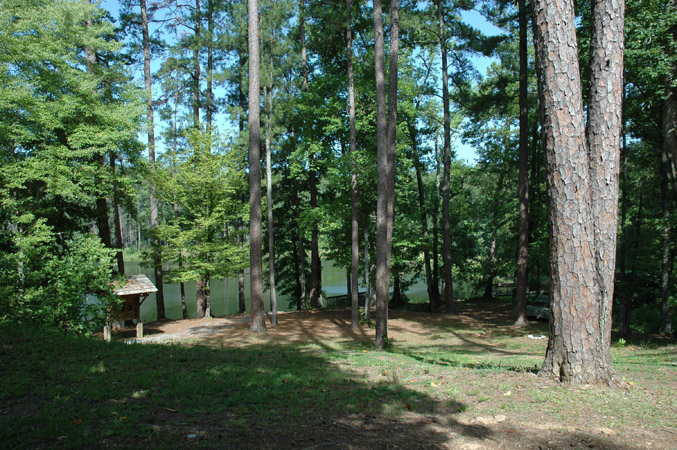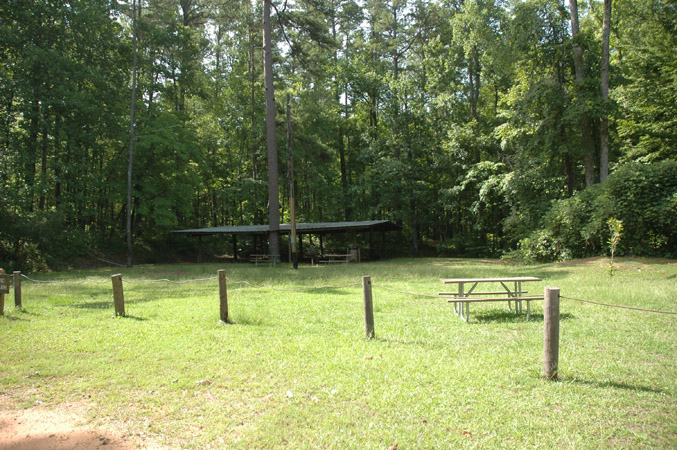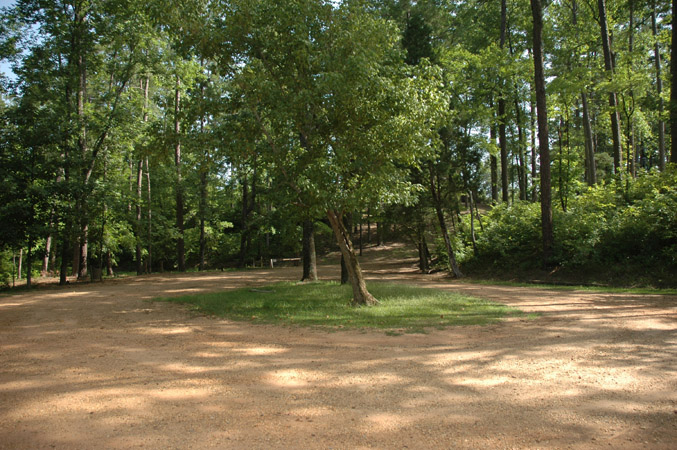Ants in Legion State Park, Winston County, Mississippi [MS State Park Ants]
Joe A. MacGown and JoVonn G. Hill
Uploaded on 6 August 2006; updated 12 June 2010
Legion State Park is located in Louisville in Winston County, Mississippi. The park is among the oldest in the state and has a couple of nice hand hewn cabins and a similarly constructed lodge. The park is located in a beautiful old mixed forest with steep ravines. Two small lakes are present, which are an attraction to local fishermen.
We collected ants at Legion State Park on 4 August 2006, arriving at the park at 8:20 hoping to beat the heat a little. Of course, it was already hot, but not as bad as it could have been. We first checked in with the office to let them know we would be collecting ants in the park. The park manager was not there, but the ranger said that would be no problem.
A view of the lower lake through the trees
We began our collections just down the hill from the office, parking in front of the pavilion that was located near the lower lake (33°09'21"N 89°02'43"W). The immediate area had lots of scattered trees, both hardwood and pine, and bordered the mixed forest. The soil was quite sandy in places, and it appeared to be slightly wetter here than other localities we had recently collected in. We began our collections by baiting several of the larger tree in the parking area with peanut butter, which we checked before we left the area.
The first ants we saw were black carpenter ants, Camponotus pennsylvanicus (DeGeer), which were very abundant and running around on the ground, on trees, picnic tables, etc. Workers of the imported fire ant hybrid, Solenopsis invicta X richteri, were also seen almost right away as they foraged on the ground. However, none of the large mounds that are typical of this species were seen. The reddish Formica pallidefulva Latreille were found nesting in the soil in open areas and were relatively common at this locality. Searching in some grass clippings at the base of a young magnolia near the pavilion resulted in a colony of Paratrechina vividula (Nylander) being found. Another common species that is associated with open areas, Forelius mccooki (McCook), was also found nesting in the soil in bare spot of the mowed grass near the pavilion.
The pavilion near the lake
While, beating Chamaecrista fasciculata along the trail bordering the lake, Camponotus americanus Mayr and Crematogaster lineolata (Say) were collected. This particular species of Camponotus is fairly easy to identify as it is brownish-red with a black head. Vegetation was also swept along this trail, with the aim being to find some of the elongate, stem dwelling Pseudomyrmex species, but none were found.
In the mixed forest, the black carpenter ant was just as abundant as in the more open areas, and was seen foraging throughout the area. Both Aphaenogaster carolinensis (Wheeler) and A. fulva Roger were collected in litter in the woods. Workers of a blackish colored species of Formica, F. subsericea Say, were collected as they foraged along the ground. Paratrechina faisonensis (Forel) colonies were found beneath leaf litter and workers were seen foraging. Two common ponerine ants, Hypoponera opacior (Forel) and Ponera pennsylvanica Buckley, were collected in litter in the woods. Likewise, two common species in the subfamily Myrmicinae, Solenopsis carolinensis Forel and Pheidole dentigula Smith, were also found in the litter. Another related species, Pheidole dentata Mayr, was found nesting in a rotting log in the mixed forest.
While in the woods five bags of leaf litter were collected to take back to the lab for Berlese funnel extraction. Several of the ants we collected by hand were in these samples, but some additional species were in there too including Brachymyrmex depilis Emery, Strumigenys ohioensis Kennedy & Schramm, Strumigenys ornata Mayr, Strumigenys louisianae Roger, Temnothorax curvispinosus Mayr, and Myrmecina americana Emery. All of these are common species in Mississippi, albeit not normally seen by the average person due to their size and cryptic habits.
As we returned to the truck, the peanut butter bait was examined to see what ants had been attracted. Bait had been placed on hardwoods and a couple of pines, but no ants were at the bait on the pine. Several species were at bait on the hardwood trees including Camponotus snellingi Bolton, Camponotus pennsylvanicus (DeGeer), Monomorium minimum (Buckley), Crematogaster ashmeadi Mayr, and Temnothorax schaumii Roger.
The parking area near the pavilion near the lake
After checking the baits we went to the primitive campground to collect for a while. We parked the truck at the end of the road and headed into the surrounding woods (33°09'20"N 89°02'43"W). This area was a bit different from the spot near the lake where we collected in that it was more flat. However, the basic species composition of ants appeared to be quite similar to the first site, although because we didn't spend as much time here, we didn't get as many species overall. One common species that we didn't get at the first site, but collected at the second site was Aphaenogaster lamellidens Mayr. A colony of this largish reddish-brown ant with blackish colored legs was collected in a rotting log. This is a very common woodland species that was undoubtedly at the first site as well, but was just not found in our limited searching. We found Aphaenogaster carolinensis in the litter, although another common related species, A. fulva, was not found. Camponotus pennsylvanicus was also very common here and was seen running about. Both the red and black Formica species, F. pallidefulva and F. subsericea, were fairly abundant. Paratrechina faisonensis and Pheidole dentigula colonies were seen just below the litter layer. The two common ponerine ants in this region, Hypoponera opacior and Ponera pennsylvanica, were also found in the litter. The little yellow Temnothorax curvispinosus was found to be very common in this area and was seen in litter, near rotting logs, and also on vegetation. We found the workers of the little black ant, Monomorium minimum, foraging on the ground. In the open area where we parked the truck we found colonies of Forelius mccooki in the soil.
While here we collected several more bags of litter, which resulted in the collection of many of the same species that we had collected by hand at this site, but also some additional species including Ponera exotica Smith, Strumigenys angulata (Wesson & Wesson), S. missouriensis (Smith), S. ohioensis, S. ornata, S. pulchella Emery, Strumigenys louisianae, Strumigenys silvestrii Emery, Trachymyrmex septentrionalis (McCook),carolinensis , and Aphaenogaster mariae Forel. Ponera exotica is a tiny, subterranean ant that was only recently discovered to occur in Mississippi (MacGown and Brown, 2006). Strumigenys angulata is considered to be a rare species in much of the United States, but has been found to be relatively common in Mississippi, especially in this part of the state (MacGown et al, 2005). We found this species at the bases of both oak and beech trees Strumigenys louisianae is a very common and widely distributed ant, whereas S. silvestrii is only known from three other localities in Mississippi. Trachymyrmex septentrionalis is a fungus growing species that we expected to find at the park, because the habitat was typical for this species. We saw several crescent shaped mounds of soil that we presumed were made by this species, but digging into the nests did not reveal any of the ants. This may have been due to the extreme heat and dry soil conditions, and the colonies may have went deeper into the soil. However, we did manage to collect one specimen of a male in oak litter. The little thief ant, Solenopsis carolinensis, was found in virtually every scoop of soil and litter we grabbed up in the park and was quite common. Only one specimen of Aphaenogaster mariae, a dealate queen, was collected, and it was also in oak litter.
Despite the extremely dry conditions around Mississippi, we ended up with 34 species from Legion State Park. This nice sampling of ants included many expected common species that are associated with forested habitats, but also a few less common species. In a recent study of the ants of Tombigbee National Forest (MacGown and Brown, 2006), much of which is in the same county (Winston County) as the state park, 72 species of ants were reported. The habitat in the park was very similar to some of the habitat found in the Tombigbee N. F., and we expected to find similar species here with the addition of any new species unlikely. For the most part this was true, and for the short amount of time we spent collecting here, we obtained a list of ants that could also be said to be fairly representative of the Tombigbee N. F. (at least the majority of it, which included rich forests located on steep slopes). In fact, we even collected some species that are considered to be either rare, only reported from Mississippi very recently, or new for the state. Strumigenys angulata and Aphaenogaster mariae are both considered to be rarely collected species in the United States (MacGown and Brown, 2006), but are not uncommon in this region of Mississippi. Aphaenogaster mariae is an interesting species that is thought to be a temporary parasite of Aphaenogaster fulva. We have found dealate queens, which are not noticeably large than the workers, in the soil in the midst of Aphaenogaster fulva colonies. At some point in time, the queen leaves the A. fulva colony and starts a new colony in a tree top, as these species are arboreal in their nesting. An easy way to capture workers is to bait oak trees with peanut butter, and then wait for the ants to make their way down the tree to the bait. Ponera exotica and Strumigenys ohioensis are both subterranean species that were only recently reported from the state (MacGown and Brown, 2006; MacGown et al, 2005). Ponera exotica appears to be uncommon in Mississippi, apparently preferring select habitats such as are found at the park here, whereas the MEM has found S. ohioensis to be widely distributed throughout the state. The most interesting and somewhat surprising find was Strumigenys silvestrii, an exotic species only previously found by the MEM in three southern counties in the state and only reported in the literature from Florida. This species represents a new state record for our state and is the northernmost record of this species to date. Strumigenys missouriensis was another species found in the state park that was not collected in the Tombigbee National Forest. This species has been only collected infrequently in Mississippi.
A subsequent trip was made to the park on 9 June 2010 by MacGown, Hill, and James Lewis. We collected at the RV campground (33°09'04"N 89°02"33"W), which was an open pine forest surrounded by a sloped, upland pine/hardwood forest. We also collected in the area near the lake located by the lodge (33°09'21"N 89°02'43"W), which was a combination of open grassy habitat, sloped, upland forests, and lake edge vegetation. At these two sites, we collected a total of 30 species, 12 of which were new for the park including Brachymyrmex patagonicus, Camponotus impressus, C. mississippiensis, C. nearcticus, Pachycondyla gilva, Discothyrea testacea, Dorymyrmex bureni, Lasius alienus, Prenolepis imparis, Proceratium chickasaw, and Strumigenys talpa . With these additional species, 47 species are now know from the park. One additional exotic species, Brachymyrmex patagonicus, the dark rover ant, was discovered in the park. This species has been rapidly increasing its range in the Southeast since its first detection in the late 1970's (MacGown et al., 2007).
List of ant species collected (arranged alphabetically by genus)
Aphaenogaster carolinensis (Wheeler)
Aphaenogaster fulva Roger
Aphaenogaster lamellidens Mayr
Aphaenogaster mariae Forel
Brachymyrmex depilis Emery
Brachymyrmex patagonicus Mayr
Camponotus americanus Mayr
Camponotus nearcticus Emery
Camponotus pennsylvanicus (DeGeer)
Camponotus snellingi Bolton
Colobopsis impressa Roger
Colobopsis mississippiensis (Smith)
Crematogaster ashmeadi Mayr
Crematogaster lineolata (Say)
Pachycondyla gilva(Roger)
Discothyrea testacea Roger
Dorymyrmex bureni (Trager)
Forelius mccooki (McCook)
Formica pallidefulva Latreille
Formica subsericea Say
Hypoponera opacior (Forel)
Lasius americanus Emery
Monomorium minimum (Buckley)
Myrmecina americana Emery
Nylanderia faisonensis (Forel)
Nylanderia vividula (Nylander)
Pheidole bicarinata Mayr
Pheidole dentata Mayr
Pheidole dentigula Smith
Ponera exotica Smith
Ponera pennsylvanica Buckley
Prenolepis imparis (Say)
Proceratium crassicorne Emery
Solenopsis carolinensis Forel
Solenopsis invicta X richteri
Strumigenys angulata (Wesson & Wesson)
Strumigenys louisianae Roger
Strumigenys missouriensis Smith
Strumigenys ohioensis Kennedy & Schramm
Strumigenys ornata Mayr
Strumigenys pulchella Emery
Strumigenys silvestrii Emery
Strumigenys talpa Weber
Temnothorax curvispinosus Mayr
Temnothorax schaumii Roger
Trachymyrmex septentrionalis (McCook)
MacGown, J. A., R. L. Brown, and J. G. Hill. 2005. An annotated list of the Pyramica (Hymenoptera: Formicidae: Dacetini) of Mississippi. Journal of the Kansas Entomological Society 78: 285–289. [pdf]
MacGown, J. A. and R. L. Brown. 2006. Survey of Ants (Hymenoptera: Formicidae) of the Tombigbee National Forest in Mississippi. Kansas Entomological Society 79: 325-340. [pdf]
MacGown, J. A., J.G. Hill, and M. A. Deyrup. 2007. Brachymyrmex patagonicus (Hymenoptera: Formicidae), an emerging pest species in the southeastern United States. Florida Entomologist 90: 457-464. [pdf]





